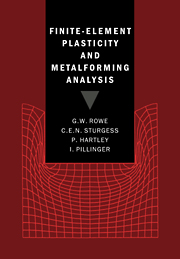Book contents
- Frontmatter
- Contents
- Preface
- Acknowledgements
- Nomenclature
- 1 General introduction to the finite-element method
- 2 Basic formulation for elastic deformation
- 3 Small-deformation elastic–plastic analysis
- 4 Finite-element plasticity on microcomputers
- 5 Finite-strain formulation for metalforming analysis
- 6 Implementation of the finite-strain formulation
- 7 Practical applications
- 8 Future developments
- Appendix 1 Derivation of small-strain [B] matrix for 2-D triangular element
- Appendix 2 Derivation of elastic [D] matrix
- Appendix 3 Derivation of elastic–plastic [D] matrix
- Appendix 4 Derivation of small-strain stiffness matrix [K] for plane-stress triangular element
- Appendix 5 Solution of stiffness equations by Gaussian elimination and back-substitution
- Appendix 6 Imposition of boundary conditions
- Appendix 7 Relationship between elastic moduli E, G and κ
- Appendix 8 Vectors and tensors
- Appendix 9 Stress in a deforming body
- Appendix 10 Stress rates
- Appendix 11 Listing of BASIC program for small-deformation elastic–plastic FE analysis
- Bibliography
- Index
8 - Future developments
Published online by Cambridge University Press: 22 September 2009
- Frontmatter
- Contents
- Preface
- Acknowledgements
- Nomenclature
- 1 General introduction to the finite-element method
- 2 Basic formulation for elastic deformation
- 3 Small-deformation elastic–plastic analysis
- 4 Finite-element plasticity on microcomputers
- 5 Finite-strain formulation for metalforming analysis
- 6 Implementation of the finite-strain formulation
- 7 Practical applications
- 8 Future developments
- Appendix 1 Derivation of small-strain [B] matrix for 2-D triangular element
- Appendix 2 Derivation of elastic [D] matrix
- Appendix 3 Derivation of elastic–plastic [D] matrix
- Appendix 4 Derivation of small-strain stiffness matrix [K] for plane-stress triangular element
- Appendix 5 Solution of stiffness equations by Gaussian elimination and back-substitution
- Appendix 6 Imposition of boundary conditions
- Appendix 7 Relationship between elastic moduli E, G and κ
- Appendix 8 Vectors and tensors
- Appendix 9 Stress in a deforming body
- Appendix 10 Stress rates
- Appendix 11 Listing of BASIC program for small-deformation elastic–plastic FE analysis
- Bibliography
- Index
Summary
INTRODUCTION
The programs described in this monograph have been developed specifically for application to metalforming, with the associated large plastic deformation and rotations produced by these processes. The emphasis throughout is on the flow of metal and the quality of the product in terms of homogeneity, residual stress and defect formation.
Various other types of program are available commercially and in laboratories. The earliest ones were extensions of linear elastic problems into small plastic deformation. As such, they are useful in structural engineering design and failure analysis. They may however lead to serious errors in the large plastic deformation range. Others concentrate on plastic deformation to the exclusion of elastic, simulating the classical rigid-plastic material of slip-line field theory. The plastic flow may be represented as a form of viscous motion, either with a constant coefficient of viscosity or of a non-Newtonian type. These are probably most suited to modelling high-temperature deformation. It is then, of course, important to include a thermal analysis which may be independent or preferably fully coupled to the incremental plasticity analysis. Elastic stresses can be determined in such solutions by a subsequent elastic unloading analysis. It is also possible to combine elastic–plastic analysis of the workpiece with an elastic analysis of the tools.
A survey of many of the programs commercially available in 1986 has been published [8.1]. Some very helpful direct comparisons are provided in that book.
- Type
- Chapter
- Information
- Finite-Element Plasticity and Metalforming Analysis , pp. 169 - 177Publisher: Cambridge University PressPrint publication year: 1991



